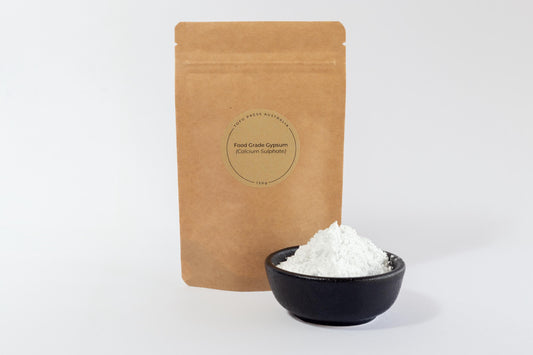
What is Tofu? - The Production, Nutrition & Sustainability of Tofu
What is tofu made from?
Tofu is a wonderfully versatile plant-based food made through a process similar to cheesemaking but instead of using dairy, it relies on soybeans. Making tofu starts with soaking soybeans and blending them into soy milk. Then, a coagulant—like nigari (magnesium chloride), gypsum (calcium sulphate) or even lemon juice—is added to the soy milk, whilst it is being heated. This coagulant works its magic by causing the proteins and fats in the soy milk to separate from the water, resulting in curds forming from the liquid.
The key players in this process are two proteins found in soybeans: glycinin and β-conglycinin. These proteins are plentiful in soybeans and have a unique ability to unfold when they encounter heat and coagulants. As they unfold, they create new bonds and trap water, which helps to create the firm texture of tofu. After that, the curds are pressed into a solid block and the amount of pressure applied will determine how firm or soft the tofu ends up being. More pressure means a firmer tofu, while less pressure yields a softer texture.
If you are interested in making your own tofu, see our easy step-by-step guide for making tofu at home.
Tofu is completely plant-based and contains no animal products. Its simplicity and adaptability make it a fantastic ingredient for a wide range of dishes, whether savoury or sweet. You can grill it, stir-fry it, blend it into sauces or even use it as a meat substitute in various recipes.
Due to its relatively neutral flavour, tofu can be easily adjusted to match different cooking styles and readily absorbs the flavours of whatever it’s cooked with. It’s also a highly nutritious food, packed with plant-based protein, vitamins, and minerals. This makes it especially popular in vegetarian and vegan diets, as it is a rich source of essential amino acids, minerals and healthy fats.
Tofu is not just a staple in many cuisines around the world; it’s also a fantastic example of how innovative plant-based food production can be, providing an eco-friendly and nutritious alternative to animal products.
Is tofu good for you?
Tofu is packed with nutrients, offering generous amounts of protein, vitamins and minerals—all while being relatively low in calories. Tofu is also considered a complete protein, meaning it contains all nine essential amino acids that the human body cannot produce on its own. This makes tofu a fantastic addition to a balanced diet, helping you up your protein intake while keeping your calorie intake in check.

Here’s a quick look at the nutrition breakdown for a 100-gram serving of firm, calcium-set tofu:
- Calories: 144
- Protein: 17 g
- Carbs: 3 g
- Fibre: 2 g
- Fat: 9 g
- Calcium: 683 mg (68% of the RDI)
- Manganese: 1.18 mg (21% of AI)
- Copper: 0.378 mg (22% of AI)
- Selenium: 17.4 µg (25% of RDI)
- Phosphorus: 190 mg (19% of RDI)
- Iron: 2.66 mg (14.8% of RDI)
- Magnesium: 58 mg (14% of RDI)
- Zinc: 1.57 mg (11% of RDI)
*RDI = Recommended Dietary Intake
*AI = Adequate Intake
See eatforhealth.gov.au for more information.
Tofu is also a great source of isoflavones (phytoestrogens), which are natural plant compounds that act as antioxidants. These isoflavones have been associated with several health benefits, such as supporting heart health and helping to balance hormones, particularly in women.
The nutritional content of tofu can vary a bit depending on the coagulant used during its production. For example:
Gypsum (calcium sulphate) = Higher in calcium.
Nigari (magnesium chloride) = Higher in magnesium.
Additionally, nigari-set tofu tends to have a bit more fat but is slightly lower in protein, fibre, potassium and calcium when compared to calcium-set tofu.
Phytoestrogens and Hormonal Balance
Tofu is packed with phytoestrogens, which are plant-based compounds that can mimic estrogen in our bodies. These little powerhouses have been linked to supporting heart health, balancing hormones, and possibly lowering the risk of certain cancers.
The phytoestrogens found in tofu, especially isoflavones, tend to bind to estrogen receptor beta (ERβ), which works a bit differently than natural estrogen. This difference is important because activating ERβ can have an anti-estrogenic effect, potentially slowing down the growth of estrogen-driven breast cancer cells.
Contrary to what some might think, the phytoestrogens in tofu don’t promote breast cancer; in fact, they might help lower the risk. Research indicates that women who enjoy more soy throughout their lives tend to have a lower risk of breast cancer, with some studies suggesting that soy could even help prevent cancer from coming back in survivors.
To learn more about soy and its effect on hormones, read our article, Is Tofu Good for You? Debunking the Most Common Myths About Soy.
Heart Health
Eating tofu regularly has been linked to lower levels of LDL (bad cholesterol) and a decreased risk of heart disease. In fact, incorporating tofu into your diet has been associated with a 21% lower risk of heart disease and a 17% lower risk of developing type 2 diabetes.
Cancer Prevention
Foods like tofu that are rich in soy may help reduce the risk of certain cancers, including breast, prostate, and colon cancers. The isoflavones in tofu might also play a role in lowering cancer recurrence rates, providing a protective effect against various types of cancer.
Bone Health and Brain Function
The isoflavones in tofu can help strengthen bones by slowing down bone loss. They may also boost cognitive functions like memory and attention.
Menopause Relief
For those experiencing menopause, tofu can be a great ally in easing common symptoms such as hot flashes and mood swings, thanks to its isoflavone content.
Antioxidant Properties
Tofu is also a source of antioxidants that provide anti-inflammatory benefits and contribute to overall well-being.
Anti-nutrients and Safety
Tofu does have some anti-nutrients, such as phytates and trypsin inhibitors, which can interfere with how our bodies absorb nutrients. But for people who maintain a balanced diet, these concerns are minor. Cooking or fermenting tofu can actually help lower these compounds and boost nutrient absorption.
While tofu is generally safe for most people, if you have estrogen-sensitive conditions, it’s a good idea to check in with a healthcare provider if you plan on eating a lot of soy.
Is tofu sustainable?
Tofu is often celebrated for its environmental advantages and is a far more sustainable choice compared to animal-based proteins. This is mainly because it requires significantly fewer resources to produce than meat, especially beef.
Land Use and Water Consumption
Tofu comes from soybeans, which need much less land and water than traditional meat production. While cattle require extensive land for both grazing and growing feed, soybeans are grown more efficiently, using less space. In fact, producing soybeans takes about 59 times less land than raising beef. The water usage is also strikingly lower; it takes around 3,171 litres of water to produce just one kilogram of beef, whereas soybeans need only a fraction of that—14 times less, to be exact.
Carbon Emissions
When it comes to greenhouse gas emissions, tofu really stands out. Beef production is a significant driver of climate change, with livestock farming releasing considerable amounts of methane and ammonia during digestion, which contribute to global warming. On the other hand, tofu production results in much lower greenhouse gas emissions. Soybean-based alternatives like tofu emit 24.5 times fewer greenhouse gases than beef, making them a much more eco-friendly protein choice.

It should also be noted that currently, 77% of global soybean production is used to feed livestock for meat and dairy production. 16% is used for biofuels, industry or vegetable oils and just 7% is used directly for human consumption.
Overall Environmental Footprint
When we take a closer look at the entire life cycle of food production, it’s clear that soy-based proteins, like tofu, have a significantly lower environmental impact. The process of making tofu is pretty straightforward: it starts with growing soybeans, then extracting the proteins and shaping them into blocks. This method is much less resource-heavy compared to the farming, slaughtering, and processing involved with cattle. The environmental advantages are evident—producing tofu uses less land and water and it generates fewer greenhouse gases.
Sure, some plant-based meat alternatives can still have their own environmental issues, especially those made with less sustainable ingredients. However, tofu really shines as a green choice. By opting for tofu, consumers can help shrink their ecological footprint and play a part in fostering a more sustainable food system.
Sources cited:
Environmental Impact of Imitation and Animal Meat Processes (2022)
Rachael Lewallen, Andrew Kearney, Yangcheng Gao, Emily Buijink
Tofu: Health Benefits and Risks - Healthline
U.S Department of Agriculture (2018) Tofu, raw, firm, prepared with calcium sulphate
Hannah Ritchie (2021) - 'Drivers of Deforestation'
Kelsey JL. A review of the epidemiology of human breast cancer. Epidemiol Rev. 1979;1:74-109.



